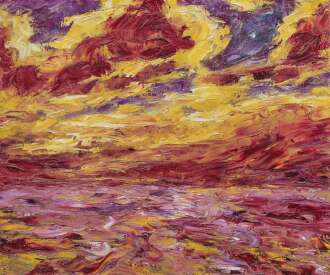Works by Emil Nolde at Sotheby's
Emil Nolde Biography
Emil Nolde is one of the most renowned Modernists. Admired for his highly influential Expressionist style, this farmer’s son born Emil Hansen in the village of Nolde in 1867 (he changed his name in 1902), had an extraordinary talent in handling colour, favouring a thick, gestural impasto. Throughout his oeuvre, the artist explored numerous Expressionist themes inspired by urban nightlife, but also diversified into Biblical scenes, dramatic ocean views and colourful flower gardens, as well as phantasmagorical subjects.
As a student in1884, Nolde trained as a wood sculptor and draughtsman in Flensburg before moving to Munich in 1897 where he attended private painting schools. Forays to Paris, where he studied Old Masters and became acquainted with Impressionism quickly, led Nolde to become known as a master of colour.
In 1906, he was invited to join the progressive art group Die Brücke (‘The Bridge’) by Karl Schmidt-Rottluff, who introduced him to woodcut techniques, while in turn, Nolde introduced the group to etchings.
Nolde tended to use many different types of media besides painting, including watercolours, drawing, and prints, to address subjects spanning flower paintings to coastal landscapes. A naturally independent personality, he left Die Brücke after only one year and was expelled from the Berliner Secession in 1910, after criticising Max Liebermann for his rejection of Expressionist paintings. In 1913, he departed for the South Pacific islands, accompanying an anthropological expedition, to conduct studies in New Guinea.
During the journey across Russia, Siberia, and Manchuria he made numerous notes and paintings. In the 1930s, Nolde became a sympathizer of the Nazi regime, despite the fact that his art was represented prominently in the infamous Nazi exhibition ‘Degenerate Art’. Between 1938 and 1945, Nolde secretly continued to paint his ‘Unpainted Pictures’.
After the war, Nolde was awarded numerous prizes and honours. In 1950, the artist was awarded the Graphics Prize, at the 25th Venice Biennale. The first documenta event, in 1955 conceived as a counterpoint to the Nazis’ Entartete Kunst (‘Degenerate Art’) exhibition contributed substantially to the myth of Nolde as a defamed artist. Nowadays, Nolde’s work is to be found in prominent international private and museum collections worldwide.
Read Less











